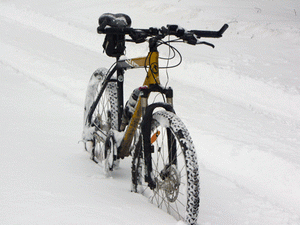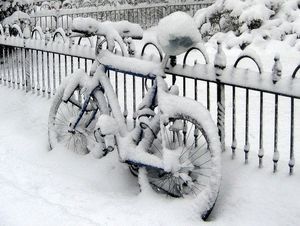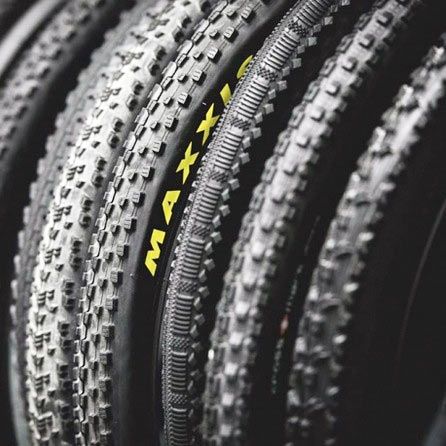 Where and How to Store a Bicycle in Winter
Among cycling enthusiasts, there are those who can’t go without their favorite mode of transportation even during winter—having purchased
winter bike tires
, they continue using this reliable companion as intended.
Where and How to Store a Bicycle in Winter
Among cycling enthusiasts, there are those who can’t go without their favorite mode of transportation even during winter—having purchased
winter bike tires
, they continue using this reliable companion as intended.
However, such enthusiasts are relatively few. For most, the cycling season ends with the onset of rain and cold weather. Where should you choose as a refuge for your beloved bicycle so that it stays intact and operational?
Where Are Bicycles Typically Stored?
 How to Store a Bicycle in Winter
Typically, bicycles are sent to winter storage in places where they won’t be in anyone’s way—this could be a balcony, shed, or garage. The luckiest bicycles are stored in the owner’s home.
How to Store a Bicycle in Winter
Typically, bicycles are sent to winter storage in places where they won’t be in anyone’s way—this could be a balcony, shed, or garage. The luckiest bicycles are stored in the owner’s home.
What risks do bicycles face when left in the cold or even just exposed to rain and snow?
Rust, which will spread across all the metal components of the two-wheeled machine. It will then be challenging to eliminate, and the bike’s lifespan will dramatically decrease.
The rubber tires are also sensitive to temperature fluctuations, especially sudden changes. Winter frost, even without temperature swings, can severely damage the material. Under its influence, the rubber will lose its elasticity and start cracking.
Bicycle Tires All nuances of choosing bicycle tires for various conditions and riding styles are covered on our website.
Also, on our website , you can find a story about wingsuit flying.
How to Properly Store a Bicycle
To avoid these issues and keep your iron friend in good working condition, it’s important to follow certain rules for its maintenance.
Bicycle Preparation
Preparations for storage start with washing the bike. Thoroughly clean every component to remove all dirt and dust. Then, dry it thoroughly and leave it to air dry completely.
Conduct a thorough inspection afterward. There may be minor repairs that require attention.
It’s advisable to loosen the brake spring cables.
Next, clean the chain with a brush, followed by a dry cloth. Then, grease it well. If left stationary for a long time, the chain may rust and will need replacement in the spring. So, it’s better to take care of it in advance. If the bicycle will winter inside a warm apartment, this preparation will suffice.
However, if the bike will be stored in a cold garage or on a balcony during winter, additional protective measures are required. These include using a preservative lubricant. Apply it to all chrome parts of the bike, and wipe mechanical components with an oily cloth or sponge to prevent corrosion from damaging them.
Don’t forget about the rubber tires to ensure they can withstand the cold. Coating them with glycerin both inside and out will help protect against frost—this softens the rubber and prevents cracking.
Choosing a Storage Location
 Where to Store a Bicycle
The best storage option for a bicycle is, of course, a space with consistently warm temperatures and low humidity, such as an apartment. To keep it out of the way, you can suspend the bike on wall mounts.
Where to Store a Bicycle
The best storage option for a bicycle is, of course, a space with consistently warm temperatures and low humidity, such as an apartment. To keep it out of the way, you can suspend the bike on wall mounts.
Another option for in-apartment storage is disassembling the bike—remove the wheels, turn the handlebars by 90 degrees, and unscrew the pedals, then reattach them from the opposite side so they face inward. It’s better to store the bike parts separately.
Nowadays, there are cabinets specifically designed for bicycle storage, but these are more likely to be purchased by professional cyclists who own expensive models of two-wheeled machines.
A very important detail when storing a bicycle indoors is its placement at a significant distance from heating radiators and any heating devices. High temperatures, like cold ones, are not favorable for the bike.
If you decide to store your bicycle on the balcony, you need to be cautious about moisture affecting its metal parts and sunlight impacting its rubber components. If the balcony is enclosed and there isn’t much humidity, then the lubricated metal parts will remain safe. However, rubber can suffer from UV sunlight exposure. In this case, you can opt for dismantling the bicycle—store the metal parts on the balcony and keep the wheels inside your apartment’s storage room. Yet, in this case, you will need to inflate the tires with a pump every month and make sure not to forget this procedure. This way, the rubber will stay intact until spring.
If space in the apartment or on the balcony does not allow you to store such a large item, you’ll have to use the garage. There, you can keep the bicycle fully assembled after treating it with grease and glycerin. It is important to find a way to suspend the bicycle so that its weight does not press down on the inflated tires. Otherwise, you’ll have to replace them by spring. You can also dismantle the wheels and take them to a warm place, leaving the frame in the garage.
There’s another storage option. Some bike repair workshops have specially equipped areas resembling garages where bicycles awaiting repair in the summer are stored. Since such garages are often empty in winter, they provide temporary housing for bicycles, although not free of charge, of course. These workshops have expanded their services to include picking up bicycles for winter storage directly from your home and delivering them back in the spring. They might also offer you a technical inspection and fix any issues if necessary. In such a setting, your bicycle will be in good hands, and you won’t need to worry about lubricating or storing it properly.
Snowboard or Alpine Skis? What should you choose for descending slopes: snowboarding or alpine skiing ? Our article will help beginners decide on their winter sports adventure.
Don’t miss our story about an “exotic” lightweight flying vehicle that takes off like a small airplane or glider but lands vertically, like a helicopter.
Check out our skydiving page for information about parachuting.
Bicycle Storage Cover
 Bicycle in a cover
A storage cover is a very handy accessory for storing and transporting a two-wheeled vehicle. You can sew one yourself or purchase it in a specialty sporting goods store.
Bicycle in a cover
A storage cover is a very handy accessory for storing and transporting a two-wheeled vehicle. You can sew one yourself or purchase it in a specialty sporting goods store.
If you decide to sew the cover on your own, canvas is the best material to use. Be sure to include a convenient zipper or velcro closure. It’s great if the cover has special handles so that it can be easily hung on the wall.
If you’re purchasing one from a store, consider the various options available. After all, a storage cover is not just useful for winter storage but also for transportation, for example, on a car rack when you’re heading to a countryside retreat with your family. For such transportation, the cover is a must to protect the car from accidental scratches caused by protruding metal parts of the bicycle.
An additional advantage of a storage cover for use in an apartment is that the bicycle won’t collect dust, and cleaning a full-cover is very simple, even with a vacuum cleaner.
If you hang the covered bicycle higher, it won’t create obstacles with its protruding parts.
The downside of a cover is that it won’t protect the bike from temperature fluctuations.
By putting in a little effort to prepare your two-wheeled friend for winter storage in the fall, it will reward you with flawless performance in the spring!



